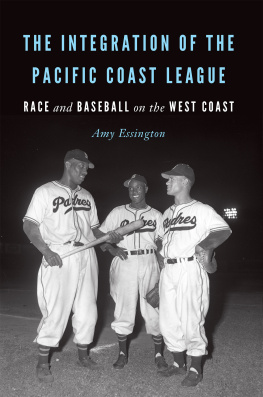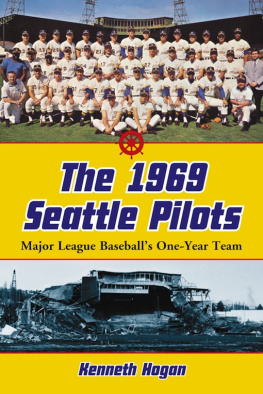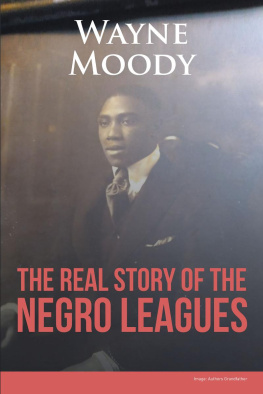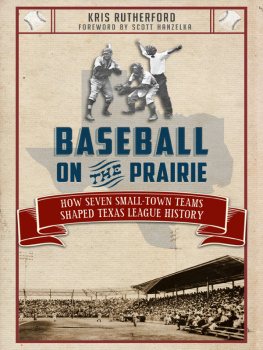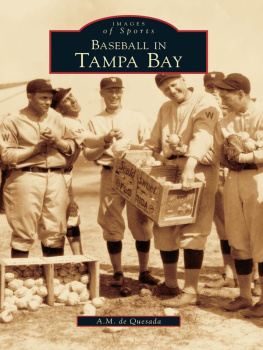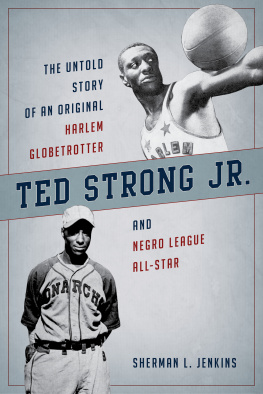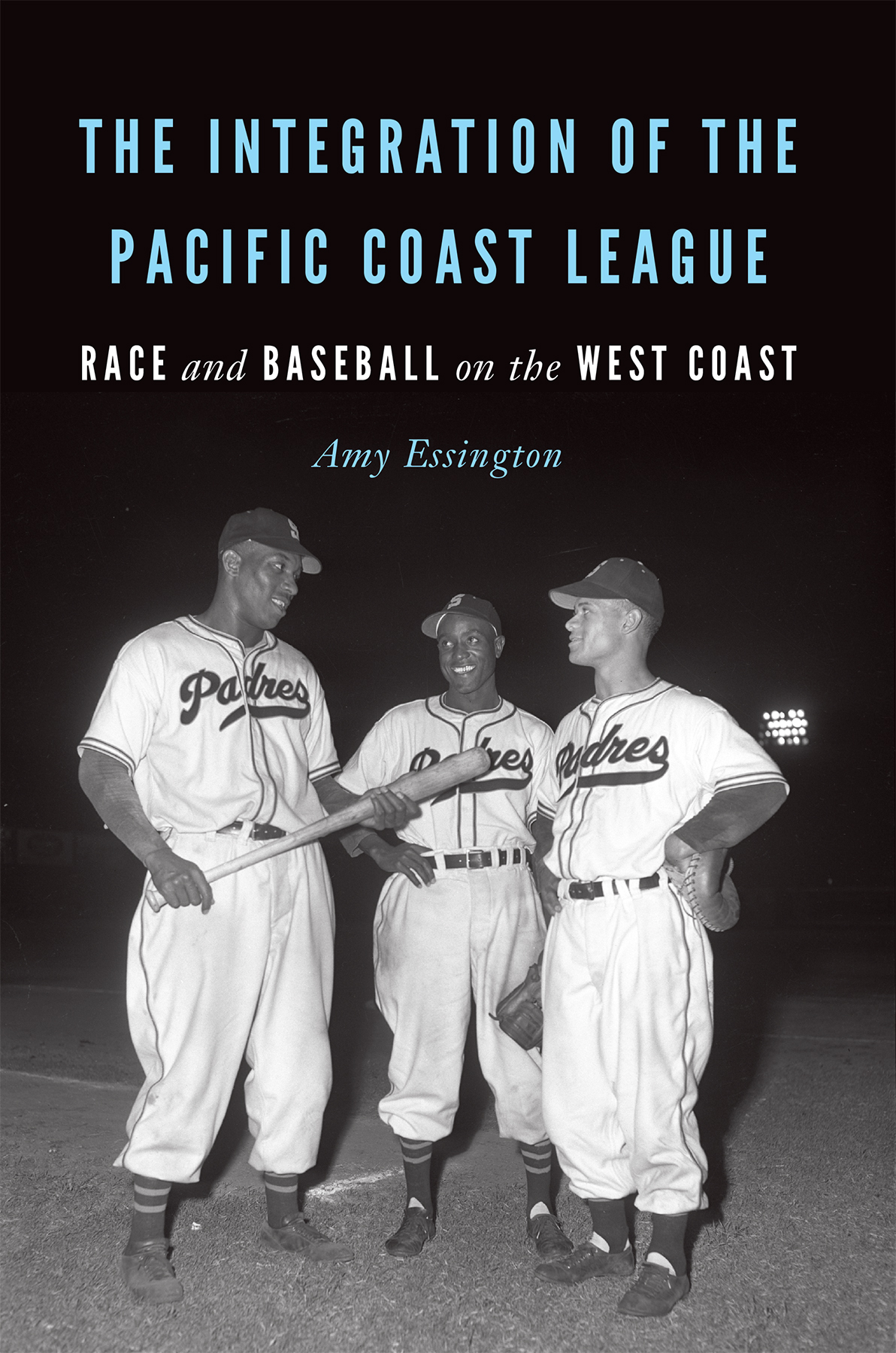The desegregation of the Pacific Coast League is a story that has never been fully told until now. Amy Essington gives a thorough account of the process and the individuals.... Essington explains the story beyond Robinson and Rickey. A definite must-read.
Based on a subject that has received too little attention from sports historians, The Integration of the Pacific Coast League explores the important role that the PCL played in the integration of baseball and how it became one of the first sports leagues to be fully integrated.
Dick Beverage, founder and former president of the Pacific Coast League Historical Society
The Integration of the Pacific Coast League
Race and Baseball on the West Coast
Amy Essington
University of Nebraska Press | Lincoln and London
2018 by the Board of Regents of the University of Nebraska
Parts of chapters 35 were originally published in Equality on the Baseball Diamond: Integrating the Pacific Coast League, 19481952, Journal of the West 47, no. 4 (Fall 2008). 2008 by ABC - CLIO , LLC . Reprinted with permission of ABC - CLIO , LLC .
Cover designed by University of Nebraska Press; cover image courtesy of the San Diego History Center.
All rights reserved
Library of Congress Cataloging-in-Publication Data
Names: Essington, Amy, author.
Title: The integration of the Pacific Coast League: race and baseball on the West Coast / Amy Essington.
Description: Lincoln: University of Nebraska Press, 2018. | Includes bibliographical references and index.
Identifiers: LCCN 2017043081
ISBN 9780803285736 (paperback: alk. paper)
ISBN 9781496207074 (epub)
ISBN 9781496207081 (mobi)
ISBN 9781496207098 (pdf)
Subjects: LCSH : Pacific Coast LeagueHistory20th century. | BaseballPacific StatesHistory20th century. | Discrimination in sportsPacific States. | Discrimination in sportsUnited States. | BaseballUnited StatesHistory. | BISAC : SPORTS & RECREATION / Baseball / History. | SOCIAL SCIENCE / Ethnic Studies / African American Studies. | HISTORY / United States / State & Local / West ( AK , CA , CO , HI , ID , MT , NV , UT , WY ).
Classification: LCC GV 875. P 33 E 77 2018 | DDC 796.3570979dc23
LC record available at https://lccn.loc.gov/2017043081
The publisher does not have any control over and does not assume any responsibility for author or third-party websites or their content.
For Ian
Contents
In many ways this book began with Effa Manley, co-owner of the Newark Eagles and 2006 Baseball Hall of Fame inductee. A white woman who chose to live her life as an African American, Manley challenged racial and gender roles throughout her life. Her story led me to the Negro Leagues and then to the integration of baseball. My interest in integration grew the summer I worked as an intern in the library at the National Baseball Hall of Fame. A native Californian, I was always in search of material about baseball on the West Coast. I combined my interest in integration and my desire to learn more about baseball on the West Coast and began researching the integration of the Pacific Coast League ( PCL ). As I explain in the introduction, it was a more difficult prospect than I had originally thought it would be.
Many people have helped me during the process of writing this book. First, thank you to Janet Farrell Brodie, Samuel O. Regalado, and Jack Schuster. Their patience and encouragement helped me continue to move forward even as the years passed. Their knowledge and critiques helped me produce a better product. I would like to include a special note about Jules Tygiel. He passed away in 2008, before I completed the project. His contributions to this field of history were numerous, and this book would not have been possible without his work.
Many people helped me with research and finding material, including Dick Beverage, the former president of the Pacific Coast League Historical Society; Eric Enders and Tim Wiles at the National Baseball Hall of Fame; and the members of the local chapters of the Society for American Baseball Research ( SABR ) in California, Oregon, and Washington. A special thank-you to Bill Swank, who connected me with John Ritcheys notebook and his widow, Lydia. This manuscript has been improved by the work at the University of Nebraska Press of Rob Taylor, senior acquisitions editor; Courtney Ochsner, associate acquisitions editor; and Annette Wenda, copyeditor.
On a personal level I would like to thank friends and relatives who let me stay with them during research trips, including Caroline Castaneda, Craig and Mitzi Elsten, and Renee and Kurt Rupe. Thank you to Dee Abrahamse for reading chapters multiple times. I would also like to thank Lara Godbille; Laurie Richlin; my in-laws, Jim Welke and Barbara Wood; and my parents, John and Patricia Essington, for their support. Most of all, I wish to thank Ian Welke, who knew before I did that we would make a good team.
This is a story about individuals who wanted to play a game they loved, baseball. For many years the game denied some of these players access to the sport because of their race. With pressure from the outside, the power structure changed, and those previously denied finally had the opportunity to prove their skills as professional baseball players. This book examines the integration of the Pacific Coast League, a minor baseball league in the three states along the Pacific Coast, from 1903 to 1957. While the PCL was not the first Minor League to integrate (that milestone went to the International League in 1946), it was the first league in baseball, at either the Minor or the Major League level, to have each of its teams include a player of color on its roster during the regular season. The integration of the PCL happened over five seasons, from 1948 to 1952. I began this project with the name of each player who integrated each PCL team. It became important to me to compile a full story of which players joined what teams and when and also to examine the process of integration in the PCL .
This is the first work to examine the integration of a Minor League. In Brushing Back Jim Crow: The Integration of Minor League Baseball in the American South (1999), Bruce Adelson examined the integration of Minor Leagues in the South, but he focused on a region of the country, not on any particular league in the South. When we understand integration in a specific league, the roles of individuals in the process of integration become more apparent. By defining who decided when a team or a league would segregate and who decided when they would integrate, we can learn much about racism and the process of integration. In studying Major League Baseball ( MLB ), the answer to the first part of the question is usually Cap Anson, a player-manager who refused to play against African Americans in the 1880s, and the answer to the second part of the question is Branch Rickey, the president of the Brooklyn Dodgers, who signed Jackie Robinson to a professional baseball contract in 1945. The experiences of these two individuals, who are well known to integration history, do not tell the whole story. Integration was a process that involved hundreds of players on dozens of teams in tens of leagues across the country and over decades. If the story of integration ends with Jackie Robinson and Branch Rickey, we lose the story that happened to everyone beyond those two men and the larger understanding of integration in sport as part of the social movement for civil rights that grew and developed during and after World War II.

